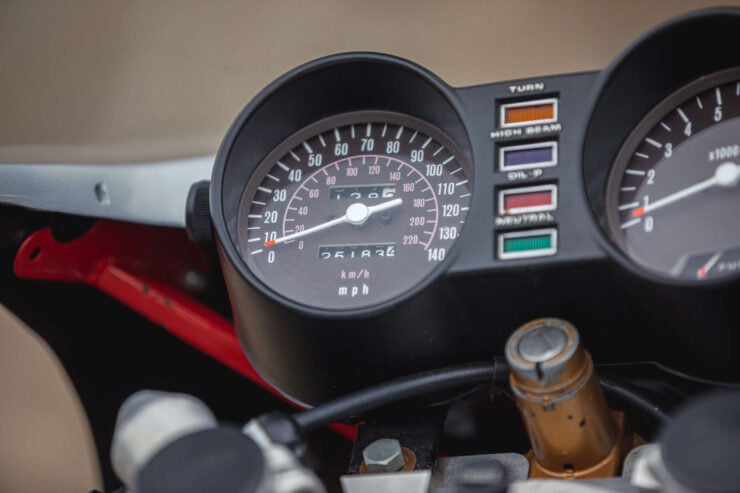The Bimota SB3 held the top speed record (at the time of its release) for production motorcycles, clocking 149 mph at the Nardò Ring in southern Italy. The SB3 was also one of the most expensive motorcycles of its time, and with just 402 made in total it was exceedingly rare.
Bimota is an Italian motorcycle manufacturer that specializes in wildly innovative motorcycles, it was founded in 1974 by Valerio Bianchi, Giuseppe Morri, and Massimo Tamburini. The company takes its name from the first two letters of each of their surnames linked together – Bianchi Morri Tamburini.
Fast Facts – The Bimota SB3
- The Bimota SB3 was the third Suzuki-powered Bimota motorcycle, it was the fastest production motorcycle in the world when it was released, and one of the most expensive.
- The SB3 followed the Bimota tradition of incorporating an advanced Japanese engine with advanced Italian chassis, suspension, and braking technology.
- Power is provided by the double-overhead cam, air-cooled Suzuki transverse four-cylinder motor from the Suzuki GS1000, producing 87 bhp at 8,200 rpm and 62 ft lbs of torque at 6,500 rpm.
- The SB3 has a bespoke tubular trellis frame made from chromoly steel, with 38mm Marzocchi forks up front and a monoshock in the rear.
Fixing The Japanese Superbike’s Achilles Heel
With the release of the Honda CB750 in 1968 Japan had taken the lead in the global superbike race, in fact the very term “superbike” was coined by a magazine reviewer to describe the model.
Despite the advanced and reliable engineering that so often went into Japanese superbike engines of the late 1960s and 1970s they frequently had a glaring Achilles heel – their frames, suspension, and brakes were subpar, and often incapable of properly exploiting the potential of their engines.


Italian engineering firm Bimota was founded specifically to address this problem. They created advanced frames and fairings which were then paired with high-end suspension and brakes. These would then either be sold as a rolling chassis for the customer to install a Japanese superbike engine into, or the Bimota factory themselves would source the engine and sell the completed motorcycle.
Bimota initially developed rolling chassis for superbike engines from Kawasaki, Honda, and Suzuki. They would later develop motorcycles for Ducati and Yamaha engines, and at one point they developed a motorcycle for supercar manufacturer Lamborghini.
Bimota’s naming convention for their motorcycles is nice and simple. The first initial of the model name is the first letter of the engine manufacturer’s name, the second letter is “B” for Bimota of course, and the number represents how many models have been developed for the engine manufacturer.
So the Bimota SB3 has a Suzuki engine in a Bimota frame, and it’s the third motorcycle developed by Bimota for Suzuki engines – SB3.


The Incredible Bimota SB3
With its almost 150 mph top speed, the Bimota SB3 was the fastest production motorcycle in the world when it was released, though there has been some contention about the record held by the model as the vast majority of them were actually sold as rolling chassis minus their engines, which needed to be sourced by the buyer from a Suzuki GS1000.
Some have thus argued that they can’t be classified as production bikes as a result, though it’s important to note that at least 66 were built entirely at the factory.
“The SB3 1000 replaced the SB2 750, but also adopted a more conventional look, devoid of those daring ‘solutions’ that so strongly marked the previous model. It was created at the express request of the German market, which at the time accounted for the vast majority of the (Bimota) motorcycles manufactured.”
“Reaching a speed close to 240kph (149mph) on that track at Nardo…it held the absolute top speed record of the period for production motorcycles.” – Bimota, 25 Years of Excellence, Giorgio Sarti.


The Bimota SB3 has a tubular steel trellis frame made from chromoly steel alloy, it has a bespoke aerodynamic fairing, and its frame uses the Suzuki GS1000 engine as a stressed member for added rigidity. The front suspension consists of a pair of 38mm Marzocchi forks, and in the rear there’s a custom monoshock arrangement that was well ahead of its time.
Brakes consist of twin 280mm Brembo discs up front and a matching disc on the back. All-in-all the Bimota SB3 tips the scales at 445 lbs dry, 62 lbs lighter than the 507 lb dry weight of the GS1000.
Thanks to the vastly improved frame, suspension, and brakes the SB3 is considerably quicker around a circuit than the bike originally designed for the same engine.
The Bimota SB3 you see here is due to cross the auction block with Silverstone Auctions on the 12th of February with a price guide of £10,000 – £12,000, which works out to approximately $13,400 – $16,080 USD. If you’d like to read more about it or register to bid you can click here to visit the listing.











Images courtesy of Silverstone Auctions








